Do you have a question about the Kenmore 385.17630 and is the answer not in the manual?
Read and follow all safety rules and operating instructions before using the sewing machine.
Information regarding the warranty coverage and terms for the sewing machine.
Details about the machine's capabilities, including speed, stitch length, and dimensions.
Instructions on how to use the sewing machine and its various functions.
Guidance on cleaning, lubricating, and maintaining the sewing machine for optimal performance.
Guidance on identifying and resolving common problems encountered while using the sewing machine.
Critical safety warnings for preventing electric shock, emphasizing unplugging and avoiding water.
General safety warnings to prevent burns, fire, electric shock, or injury to persons during operation.
25-year warranty for defects in material or workmanship of the sewing machine head.
2-year warranty covering electrical and electronic components of the sewing machine.
90-day warranty for parts replacement and mechanical service, excluding normal maintenance.
Specifies maximum sewing speed, stitch length, and stitch width.
Provides the physical dimensions and net weight of the sewing machine.
Diagram and list of major parts of the sewing machine, including controls and external features.
Diagram and identification of the sewing machine's foot control pedal.
Information required when ordering replacement parts for the sewing machine.
Diagrams and part numbers for various optional accessories and attachments.
Step-by-step instructions for connecting the sewing machine to the electrical power supply.
Essential safety precautions to follow while the sewing machine is in operation.
Basic operational guidelines, including polarized plug information and foot controller usage.
Explanation of how to adjust sewing speed using the foot control pedal.
How to adjust the presser foot pressure for different fabric types and sewing tasks.
Description of the presser foot lifter's function and its extra height capability.
Instructions on using the integrated thread cutter for convenient thread trimming after sewing.
How to attach/detach the extension table and access the accessory box.
Step-by-step guide on how to properly remove and insert a sewing machine needle.
Instructions for removing and attaching the sewing machine's foot holder.
Procedure for removing and attaching various presser feet to the machine.
Use for straight and zigzag stitching; suitable for various stitches like bar tacking and overcasting.
Exclusively for straight stitching with the needle in the center position.
Used for manual buttonholing, aiding in accurate measurement.
Designed for sewing zippers, guiding the fabric for straight seams.
Transparent foot for satin stitch, outlining, and applique work.
For perfect blind hemming, guiding the folded edge of the hem.
For stitching and overcasting seams, controlling fabric and preventing puckering.
Enables one-step automatic buttonholing; size set by button placement.
Converts zigzag foot to a quilting foot for guiding quilting stitches.
Guide to choosing appropriate needle sizes and thread types for various fabrics.
Instructions for winding bobbins using the standard horizontal spool pin.
Instructions for winding bobbins using the additional spool pin for convenience.
Detailed steps for winding thread onto the bobbin, including stopping and cutting.
Guidance on adjusting the bobbin winder stopper for desired bobbin fill amount.
Step-by-step guide for threading the upper needle thread through the machine.
Instructions on how to bring the bobbin thread up through the needle plate.
Guide to selecting stitches using the selector dial and understanding window displays.
Explanation of color-coded zones for stitch patterns and recommended settings.
How to adjust the stitch width control for desired stitch width, including special zones.
How to adjust the stitch length control for desired stitch length, including stretch stitch settings.
How to adjust stitch patterns for evenness using the feed balancing dial.
Explanation of how to use the reverse stitch control for reinforcing seams.
How to start and finish a straight stitch seam, including reverse stitching.
Instructions on using the engraved seam guides on the needle plate for measuring seam width.
Technique for turning a square corner while sewing a straight stitch.
How to attach and use the quilter guide for consistent quilting stitch lines.
How to perform topstitching to create decorative lines and crisp edges on garments.
Using the quilter attachment to sew straight quilting lines with consistent spacing.
How to attach the zipper foot correctly for sewing zippers on either side.
Steps for preparing the fabric, including folding and pinning, before sewing a zipper.
Detailed instructions on sewing the zipper, including folding allowances and seam finishing.
Steps for finishing the zipper sewing, including adjusting the foot and securing the seam.
How to operate the lever to raise or drop the feed dogs for normal sewing or darning.
Instructions for darning fabric, including setting the machine and guiding the fabric.
Description and settings for the basic zigzag stitch, used for various applications like sewing buttons and overcasting.
How to use the satin stitch for decorative purposes, edge finishing, and applique work.
Instructions for creating monograms using satin stitch, including stabilizer and chalk marking.
How to stitch applique pieces onto fabric, ensuring the needle follows the raw edge.
How to use bar tacking to reinforce points of strain like corners and pockets.
Instructions for free-motion embroidery, including fabric stretching and needle thread tension.
Guide to sewing buttons securely, including thread strengthening and feed dog settings.
How to use the overcasting stitch for finishing raw edges and preventing fraying.
Technique for creating invisible blind hems, including fabric folding and needle position adjustment.
Using the multiple zigzag stitch for seam finishing, darning, and mending tears.
Adding decorative lace to garments and home decor, including folding and topstitching techniques.
Using the multiple zigzag stitch for finishing seam allowances on synthetic fabrics and for mending.
How to sew shell stitches on lightweight fabrics like tricot, including folding and tension adjustments.
Using the box stitch to join heavyweight interlining edges.
Joining fabric pieces with a fagoting stitch for an open-work appearance.
A decorative stitch often used as a single overlock stitch.
Useful for joining elastic fabrics with a box-like stitch.
Used as a seam finish to prevent fraying, ideal for garment construction.
Creating decorative patterns on delicate fabrics like chiffon with tear-away backing.
Durable stitch for elasticity and strength, used for reinforcing seams and preventing puckering.
Using zigzag stitch for stretch fabrics, also serves as decorative topstitching.
Sewing seams with an overcast finish for stretch garments like swimwear.
Decorative treatment for children's clothes, involving gathering fabric and decorative stitches.
Creating narrow seams with an overcast finish, ideal for knits and swimwear.
Attaching elastic to garments by marking and matching quarters, ensuring even distribution.
Using a stitch for patching worn areas like elbows or knees, and for patchwork quilting.
Attaching the automatic buttonhole foot and preparing the machine for buttonhole sewing.
Step-by-step process for sewing automatic buttonholes, including button placement and test sewing.
How to mark the buttonhole on fabric and align it with the machine guides for accurate placement.
How to adjust stitch density for buttonholes by changing stitch length settings.
How to adjust stitch balance for buttonholes to ensure even sides, using a screwdriver.
Procedure for sewing corded buttonholes, including cord placement and tension adjustments.
Step-by-step instructions for sewing manual buttonholes, including needle and foot positioning.
How to adjust stitch density for manual buttonholes by changing stitch length settings.
List and diagrams of parts included with the optional automatic buttonhole attachment.
Templates for round end and keyhole buttonholes, showing available sizes.
Detailed steps for sewing automatic buttonholes, including needle positioning and fabric feeding.
Instructions for cutting the buttonhole opening and releasing the base plate.
Detailed steps for sewing manual buttonholes, including fabric edge alignment and stitch density.
Steps for setting up the machine with an additional spool pin and twin needle.
Guide to threading the machine with two threads, ensuring correct placement.
Instructions for safely replacing the sewing machine's light bulb.
How to clean dust and lint from the bobbin area and hook cover plate for optimal performance.
How to clean dust and lint from the hook race and feed dogs using a brush or vacuum.
Instructions on where and how often to oil the machine for proper lubrication.
Causes and solutions for the needle thread breaking during sewing.
Causes and solutions for the bobbin thread breaking.
Causes and solutions for the sewing needle breaking.
Causes and solutions for skipped stitches, including needle insertion and thread tension.
Causes and solutions for fabric puckering during sewing, related to tension and pressure.
Causes and solutions when the fabric is not feeding smoothly, related to feed dogs and presser foot.
Troubleshooting steps for when the sewing machine does not operate, checking power and thread jams.
Causes and solutions for distorted stitch patterns, related to stitch balance.
Causes and solutions for excessive noise during sewing, related to lint and thread jams.
Read and follow all safety rules and operating instructions before using the sewing machine.
Information regarding the warranty coverage and terms for the sewing machine.
Details about the machine's capabilities, including speed, stitch length, and dimensions.
Instructions on how to use the sewing machine and its various functions.
Guidance on cleaning, lubricating, and maintaining the sewing machine for optimal performance.
Guidance on identifying and resolving common problems encountered while using the sewing machine.
Critical safety warnings for preventing electric shock, emphasizing unplugging and avoiding water.
General safety warnings to prevent burns, fire, electric shock, or injury to persons during operation.
25-year warranty for defects in material or workmanship of the sewing machine head.
2-year warranty covering electrical and electronic components of the sewing machine.
90-day warranty for parts replacement and mechanical service, excluding normal maintenance.
Specifies maximum sewing speed, stitch length, and stitch width.
Provides the physical dimensions and net weight of the sewing machine.
Diagram and list of major parts of the sewing machine, including controls and external features.
Diagram and identification of the sewing machine's foot control pedal.
Information required when ordering replacement parts for the sewing machine.
Diagrams and part numbers for various optional accessories and attachments.
Step-by-step instructions for connecting the sewing machine to the electrical power supply.
Essential safety precautions to follow while the sewing machine is in operation.
Basic operational guidelines, including polarized plug information and foot controller usage.
Explanation of how to adjust sewing speed using the foot control pedal.
How to adjust the presser foot pressure for different fabric types and sewing tasks.
Description of the presser foot lifter's function and its extra height capability.
Instructions on using the integrated thread cutter for convenient thread trimming after sewing.
How to attach/detach the extension table and access the accessory box.
Step-by-step guide on how to properly remove and insert a sewing machine needle.
Instructions for removing and attaching the sewing machine's foot holder.
Procedure for removing and attaching various presser feet to the machine.
Use for straight and zigzag stitching; suitable for various stitches like bar tacking and overcasting.
Exclusively for straight stitching with the needle in the center position.
Used for manual buttonholing, aiding in accurate measurement.
Designed for sewing zippers, guiding the fabric for straight seams.
Transparent foot for satin stitch, outlining, and applique work.
For perfect blind hemming, guiding the folded edge of the hem.
For stitching and overcasting seams, controlling fabric and preventing puckering.
Enables one-step automatic buttonholing; size set by button placement.
Converts zigzag foot to a quilting foot for guiding quilting stitches.
Guide to choosing appropriate needle sizes and thread types for various fabrics.
Instructions for winding bobbins using the standard horizontal spool pin.
Instructions for winding bobbins using the additional spool pin for convenience.
Detailed steps for winding thread onto the bobbin, including stopping and cutting.
Guidance on adjusting the bobbin winder stopper for desired bobbin fill amount.
Step-by-step guide for threading the upper needle thread through the machine.
Instructions on how to bring the bobbin thread up through the needle plate.
Guide to selecting stitches using the selector dial and understanding window displays.
Explanation of color-coded zones for stitch patterns and recommended settings.
How to adjust the stitch width control for desired stitch width, including special zones.
How to adjust the stitch length control for desired stitch length, including stretch stitch settings.
How to adjust stitch patterns for evenness using the feed balancing dial.
Explanation of how to use the reverse stitch control for reinforcing seams.
How to start and finish a straight stitch seam, including reverse stitching.
Instructions on using the engraved seam guides on the needle plate for measuring seam width.
Technique for turning a square corner while sewing a straight stitch.
How to attach and use the quilter guide for consistent quilting stitch lines.
How to perform topstitching to create decorative lines and crisp edges on garments.
Using the quilter attachment to sew straight quilting lines with consistent spacing.
How to attach the zipper foot correctly for sewing zippers on either side.
Steps for preparing the fabric, including folding and pinning, before sewing a zipper.
Detailed instructions on sewing the zipper, including folding allowances and seam finishing.
Steps for finishing the zipper sewing, including adjusting the foot and securing the seam.
How to operate the lever to raise or drop the feed dogs for normal sewing or darning.
Instructions for darning fabric, including setting the machine and guiding the fabric.
Description and settings for the basic zigzag stitch, used for various applications like sewing buttons and overcasting.
How to use the satin stitch for decorative purposes, edge finishing, and applique work.
Instructions for creating monograms using satin stitch, including stabilizer and chalk marking.
How to stitch applique pieces onto fabric, ensuring the needle follows the raw edge.
How to use bar tacking to reinforce points of strain like corners and pockets.
Instructions for free-motion embroidery, including fabric stretching and needle thread tension.
Guide to sewing buttons securely, including thread strengthening and feed dog settings.
How to use the overcasting stitch for finishing raw edges and preventing fraying.
Technique for creating invisible blind hems, including fabric folding and needle position adjustment.
Using the multiple zigzag stitch for seam finishing, darning, and mending tears.
Adding decorative lace to garments and home decor, including folding and topstitching techniques.
Using the multiple zigzag stitch for finishing seam allowances on synthetic fabrics and for mending.
How to sew shell stitches on lightweight fabrics like tricot, including folding and tension adjustments.
Using the box stitch to join heavyweight interlining edges.
Joining fabric pieces with a fagoting stitch for an open-work appearance.
A decorative stitch often used as a single overlock stitch.
Useful for joining elastic fabrics with a box-like stitch.
Used as a seam finish to prevent fraying, ideal for garment construction.
Creating decorative patterns on delicate fabrics like chiffon with tear-away backing.
Durable stitch for elasticity and strength, used for reinforcing seams and preventing puckering.
Using zigzag stitch for stretch fabrics, also serves as decorative topstitching.
Sewing seams with an overcast finish for stretch garments like swimwear.
Decorative treatment for children's clothes, involving gathering fabric and decorative stitches.
Creating narrow seams with an overcast finish, ideal for knits and swimwear.
Attaching elastic to garments by marking and matching quarters, ensuring even distribution.
Using a stitch for patching worn areas like elbows or knees, and for patchwork quilting.
Attaching the automatic buttonhole foot and preparing the machine for buttonhole sewing.
Step-by-step process for sewing automatic buttonholes, including button placement and test sewing.
How to mark the buttonhole on fabric and align it with the machine guides for accurate placement.
How to adjust stitch density for buttonholes by changing stitch length settings.
How to adjust stitch balance for buttonholes to ensure even sides, using a screwdriver.
Procedure for sewing corded buttonholes, including cord placement and tension adjustments.
Step-by-step instructions for sewing manual buttonholes, including needle and foot positioning.
How to adjust stitch density for manual buttonholes by changing stitch length settings.
List and diagrams of parts included with the optional automatic buttonhole attachment.
Templates for round end and keyhole buttonholes, showing available sizes.
Detailed steps for sewing automatic buttonholes, including needle positioning and fabric feeding.
Instructions for cutting the buttonhole opening and releasing the base plate.
Detailed steps for sewing manual buttonholes, including fabric edge alignment and stitch density.
Steps for setting up the machine with an additional spool pin and twin needle.
Guide to threading the machine with two threads, ensuring correct placement.
Instructions for safely replacing the sewing machine's light bulb.
How to clean dust and lint from the bobbin area and hook cover plate for optimal performance.
How to clean dust and lint from the hook race and feed dogs using a brush or vacuum.
Instructions on where and how often to oil the machine for proper lubrication.
Causes and solutions for the needle thread breaking during sewing.
Causes and solutions for the bobbin thread breaking.
Causes and solutions for the sewing needle breaking.
Causes and solutions for skipped stitches, including needle insertion and thread tension.
Causes and solutions for fabric puckering during sewing, related to tension and pressure.
Causes and solutions when the fabric is not feeding smoothly, related to feed dogs and presser foot.
Troubleshooting steps for when the sewing machine does not operate, checking power and thread jams.
Causes and solutions for distorted stitch patterns, related to stitch balance.
Causes and solutions for excessive noise during sewing, related to lint and thread jams.
| Brand | Kenmore |
|---|---|
| Model | 385.17630 |
| Speed Control | Yes |
| Automatic Needle Threader | No |
| Drop Feed | Yes |
| Free Arm | Yes |
| Power Source | Electric |
| Voltage | 120V |
| Bobbin Type | Class 15 |
| Stitch Width | 5mm |
| Stitch Length | 4mm |
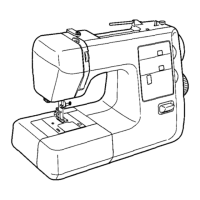





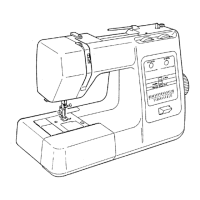
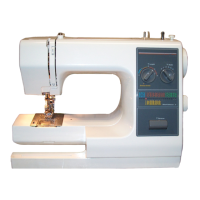


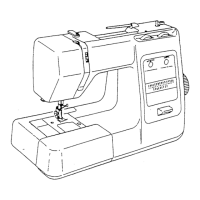
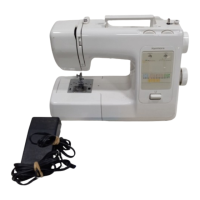
